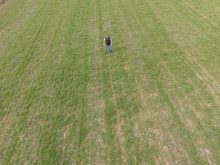Carpal tunnel is a condition that can affect anyone, anytime, though it’s especially common in those who work with their hands and do manual labour.
The carpal tunnel is an anatomical term for the path the tendons in the forearm and wrist take underneath a bridge of connective tissue in the wrist moving into the hand. Carpal tunnel syndrome and its symptoms occur when that connective tissue bridge compresses the tendons and nerves beneath it. It can also occur due to tension and irritation, starting higher up in the forearm, which leads to compression of the nerves that move alongside the tendons in that already-compressed, busy area of anatomy.
Symptoms of carpal tunnel syndrome can include numbness and pain into the hand, weakness in the hand and fingers, and pain and numbness that occur overnight and with movement or use of the hand. The common medical treatment is surgical decompression of the nerves in the area. That said, more conservative treatment — through targeted movement and mobility practices, massage and acupuncture — has been shown to be just as effective, if not more effective long-term, than surgical intervention.
Read Also

Gentle treatments for pain in the neck
Heading toward year-end, people unknowingly tense up against the cold and busyness, causing neck pain that can often be treated with appropriate support and gentle mobility, athletic therapist Kathlyn Hossack says.
Those who have experienced carpal tunnel symptoms will know how intrusive they can be. Whether you pursue surgical treatment and/or work with more conservative methods, long-term maintenance through simple daily exercises can help treat and even prevent the intrusive signs and symptoms of carpal tunnel issues.
Pieces of resistance
Some of my go-to recommendations for conservative treatment of carpal tunnel begin with simple strength exercises at the wrist junction. All you need to support this area intentionally is a hair elastic or firm elastic band. Loop the elastic band around your fingers, with the fingertips meeting each other, and slowly — like, really slowly — work to open your fingers wide into the resistance of the band. Reverse the movement just as slowly. Repeat this 10 times, two to three rounds a day, at least a few times per week.
Second to this movement is the opposite movement: using a thick ball of socks or a stress ball, practice squeezing the hand into a fist, into the gentle resistance, and slowly releasing. These two movements in combination help to reinforce the carpal tunnel and keep the tendons that run through the area feeling good.
Regularly moving the wrist through drawing circles with the hand, and working on shoulder and neck mobility, are also good tactics to ensure the carpal tunnel area remains symptom-free. Much carpal tunnel syndrome actually begins higher up at the neck and shoulder, where the nerve roots begin their path down the arm. If there is tension, joint restriction or other issues in these areas, often the symptoms manifest lower at the wrist and hand. It’s always worth exploring the whole chain from neck down to hand when there are symptoms anywhere along the arm route to the hand.
If you experience symptoms that impede your ability to function or rest appropriately, it’s important to check in with your local physical rehab specialist, massage therapist, acupuncturist and/or health care providers to ensure you get appropriate care and long-term relief as soon as possible.















